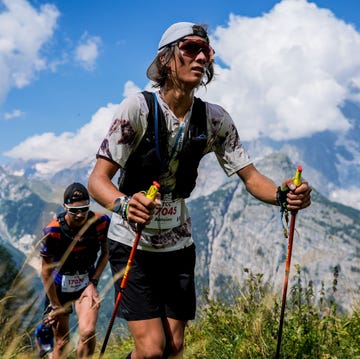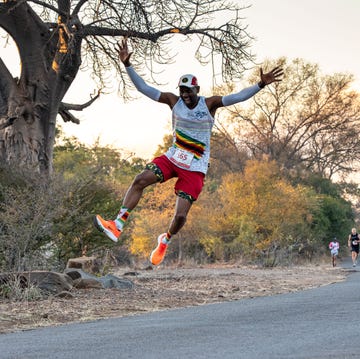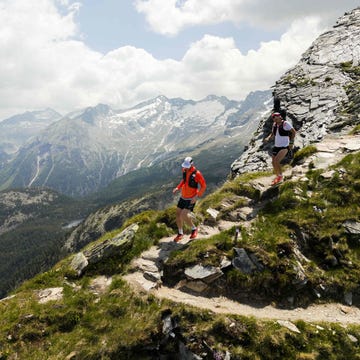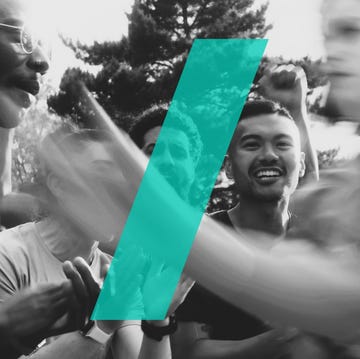Tennessee’s headline-hogging Barkley Marathons is notoriously difficult to complete, but 20 different people have managed it. Gloucestershire’s equally brutal homage to the iconic ultra so far has zero finishers.
’If anyone finishes, their name will be engraved on the bell. The bell is empty.’
It’s a Friday night in late August and race director Paul Breen is giving his pre-race briefing in the confines of Hamfields Leisure centre in Gloucestershire.
What everyone's reading
The start of the third edition of his event, the Berkeley Marathons, is a little over 12 hours away, and the anxiety in the room is palpable.
It’s easy to understand why. The route consists of five self-supported marathon-length laps. Each has to be navigated using a physical map where you’ll be disqualified if you take certain wrong turns. The cut-off is 24 hours. And there’s the small matter of 10 lockboxes that need to be cracked using a series of clues; each containing a book that runners have to rip a specific page out of to prove they haven’t skipped a checkpoint.
If that all sounds rather familiar, that’s because it is. ‘It wasn't my idea,’ confesses Breen. ‘It was completely Lazarus Lake’s.’
The extravagantly-bearded creator of the notorious Barkley Marathons, Gary ‘Lazarus Lake’ Cantrell shot to underground fame after the release of the 2014 documentary The Barkley Marathons: The Race That Eats Its Young.
‘I was at the National Running Show in 2019 just before we were prepping to go and do the Marathon des Sables and the documentary was really big,’ says Breen. ‘Laz was at the running show, and it was heaving – you couldn't get near him. As me and my partner were leaving, he was outside having a fag on his own. I popped up to him and said how much we enjoyed the documentary and mentioned that I was born and raised in Berkeley in Gloucestershire. He turned around and just went, “You should set up the Barkley Marathons UK”.’
Breen was juggling a full-time job with being a parent, running, and getting his mental health back on track after struggling to readjust to civilian life on leaving the army. He’d never put on an event before. But Lake’s seemingly throwaway comment planted like a seed in his brain.
‘While out in the desert under the bivvies doing the MDS, we were chatting about how difficult it was to raise money for charities – you're asking the same people time again to sponsor you. We joked about the Barkley and someone said, “why don't you set it up, but just give all the money to charity – and then you don't have to do it?”. That's how the idea of the Berkeley UK was born.’
Back on the banks of the River Severn, Breen, the event’s chosen charities Big Moose and Jade’s Bag, and a local ultrarunner well known to RW readers Damian Hall have wrapped up the pre-race briefing. I’m now faced with the small matter of plotting tomorrow’s route onto the blank slate I was handed at sign-on.
Sliding into the rust-coloured banquette seating, I grab one of the pre-marked Ordnance Survey maps and get to work on the Formica table. I’m instantly transported back to school and working towards my Duke of Edinburgh awards. Using a black marker, I plot my way across footpaths, bridleways and roads, and tap into memories of contour lines, abbreviations and symbols (FB equals footbridge; pint tankard, pub) to get a sense of what lies in store.
Switching to a red marker, I dot the 10 book locations and shade the areas Breen has described as ‘Mordor’ – potential shortcuts that will result in a DQ. After triple-checking that I’ve not made any mistakes, I head back to my tent for a restless, worry-filled sleep.
Rising early to carb load on jam sandwiches, I’m still unsure about what the next 24 hours will bring. A keen road runner with a marathon PB of 2:43, the furthest I’d ever run was 33.3 miles at a Backyard Ultra in March; another Lazarus Lake invention in which competitors have to complete a 4.167-mile lap on the hour, every hour, until there’s one runner left.
I’ve formulated a sliding scale of targets, ranging from two laps to 100km to three laps, but as I’ve never completed a trail marathon before and my London-based training lacks any serious hills, I know that even this might be naively ambitious.
It seems I’m not alone in effectively ruling out finishing five laps before I’ve taken my first step. Leeanna Ashford and her husband were inspired to sign up after cheering on their friends at last year’s edition. ‘We watched the really fast ones go through and also some of the ones who took a bit longer,’ she say. ‘Everybody was having a great time and we thought it would be a brilliant challenge.’ The furthest Ashford has ever run is 18 miles and the pair aim to complete one lap and then see simply how it goes. ‘Whether that takes us six hours, 10 hours… it doesn't matter,’ says the 46-year-old from nearby Sharpness.
Josh Wiley is at the other end of the proceedings. An experienced ultra runner and Barkley Marathons veteran, the 36-year-old American completed a full lap and found all the books in the 2022 edition of the US version, albeit finishing outside the cut-off time. With that pedigree in his locker, he has somewhat loftier ambitions. ‘I think anytime you go into a race that is Barkley or Barkley-styled, you should imagine yourself going the full distance because if you don't, you'll sell yourself short,’ he explains, before adding the sensible caveat that you need to, ‘recognise that you're only human and you're going to do what you can do’.
Congregating at the start, the nearby decommissioned nuclear power station looms menacingly. After a countdown from 10, Breen announces that the first lap will be counterclockwise and downs a can of beer – the non-smoker’s alternative to Lake’s quirky race-starting cigarette – and we’re off.
Settling into a steady pace, my heart rate is racing with adrenaline; I take deep breaths to try and relax but the unknown is getting the better of me. A small group is forming at the front and I decide they’re worth sticking to – safety in numbers and all of that. Approaching the first lockbox, some fears about the complexity of the clues are allayed – four basic maths equations provide the code – but as someone else has got there before me, I’m simply handed the book. Tearing my pre-assigned page out of Robert Galbraith’s The Ink Black Heart, I stuff it into my running vest before chasing after the leaders.
Heading onto the ridge of Whitecliff Deer Park, the late summer sun is already bearing down and I’m a sweaty mess after only 30 minutes. Taking in my Vale of Berkeley surroundings, I can spy the Tyndale Monument – a 34m tower and the location of book number five – atop Nibley Knoll on the horizon to the east. It’s strange to think that if I head out for lap two, I’ll be retracing my steps in however many hours from now, while if I make it to the reversed clockwise lap three, I’ll be nearing its end and definitely in the dark.
After returning from the Marathon des Sables, Breen and his partner started looking into the feasibility of setting up Barkley-inspired event. Fearing he’d get slated and slandered, he tracked down Lake via Bristol-based ultra runner and Barkley veteran John Kelly to confirm Lake hadn’t been joking – he hadn’t, but he had a condition that was something of a conundrum: ‘He said “make it nigh on impossible, but make it accessible”,’ says Breen. ‘The former was very difficult because we haven't got the terrain that Tennessee has and we're restricted on the route because we haven't got right to roam and you have to stay on paths. I chatted to a couple of people and they said “restrict the time”. I was originally going to give 48 hours and Kelly said, “No, do 24”. There are races out there of a similar distance, where people have run it in 22-23 hours, so it can be done. They said a woman would never do the Barkley, but it happened.’
Even without the time limit, I’m starting to find the course has its own nigh-on-impossibilities. Unfamiliar fields with hard-to-find stiles; a lockbox in an underpass beneath the M5 that requires the use of a UV light, illuminating why it was included on the mandatory kit list; wildlife like cows, goats and horses that seem to be attracted to us like moths to a flame.
Fortunately, we have a veteran in our midst. Stuart Scott has completed three laps in both of the previous editions of the Berkeley Marathons, and the 46-year-old from Durham is acting as a defacto guide. ‘I'm a massive fan of ultrarunning, have been doing it for a number of years, and the original race intrigues me,’ he says. ‘I absolutely love it, and I am very aware that my skills will get me absolutely nowhere in the real event. The second this idea was published about a UK tribute race, I thought, “that sounds absolutely perfect for me, because they will actually let me come and do that one!”.
‘I also know with the proper one that the people who do well work off veterans,’ Scott continues. ‘Part of my idea with signing up for the first one was, if I can encourage some runners that I know that are a lot better than me to come the second year, it means I will be able to assist them.’
While Scott is selflessly pointing out tricky things to bear in mind for future laps, he’s also encouraging a competitive pace. ‘I know I could take it easy again and probably get three laps, or I could go the pace that I know is needed to have any chance of doing a fourth,’ he explains. Chatting away throughout, even if I lose sight of Scott, I stay close enough to hear him, and let his friendly northeastern lilt shepherd me round.
Passing through a farm, the Tyndale Monument comes back into view, and with it the first serious climbing of the day. To reach the tower’s base and the fifth book, there’s the not-so-small matter of Nibley Knoll to summit – a 600m-long off-road climb with an average gradient of 12%. Spooked by rumours that Breen has got some sadistic tricks in store, everything becomes a potential clue. I spot an open tin of Fray Bentos meatballs on the floor and lift it to snap a picture of its expiry date.
While this might sound like I’ve already descended into madness just 10 miles in, it’s not without precedent. In 2023, runners climbed all 121 steps to the top of the tower to be informed that the code for the box was on the back of the door at its entrance. After descending the claustrophobic stone spiral staircase they’d just clambered up, the note on the door revealed that the code was actually on the underside of the lockbox, back at the top of the tower.
After ascending the knoll, a lockbox is located near the foot of the tower, but on opening it, instead of a book there’s a button which, when pressed, screams ‘unlucky’. Knowing that the only way from here is up, I embark on my first ascent of the monument, praying that I’ll only have to do it once this lap. The book, Les Miserables, is cable-tied at the top. Tearing out the page, I wonder if its title is a foretelling of how I’ll be feeling on my next visit.
Descending at speed into North Nibley on the same hill I’d just climbed, I spot two similar out-and-back spurs to book locations on the map where the contour lines are squished tight like a compressed concertina. It’s not long before I’m up on Stitchcombe Hill golf course and embarking on the first – possibly the steepest decline I’ve ever run down. My brain tells me to go with the flow, but as I near terminal velocity, my instinct cuts in and my legs stiffen like someone has pulled a handbrake, pounding my quads on the steep, uneven terrain. I’m also aware that once I reach the bottom I’m going to have to turn around and head straight back up; it’s the first serious mental blow the course has landed on me.
The second spur is more of the same, although its tarmac terrain feels slightly more predictable underfoot. Descending for the third and final time off Stinchcombe Hill, I’ve broken the back of the first lap and ticked off most of the climbing, but my lower half feels like jelly. Lofty goals of three laps are already fading, but I’m not ready to throw in the towel yet.
Reaching Sharpness Docks and the final book, the power station is a short jog down the Severn Way. My GPS watch tells me that I’ve already eclipsed a marathon and I estimate I’ve still got a little more than a mile to go. Entering the Race HQ, the clock is stopped at 4:49. To do all five laps within the 24-hour cut off, I’d need to marginally improve on this pace for the next 19 hours. The way my legs are feeling, I’d do well to complete another one in that time.
I wash peanut butter sandwiches down with a slurp of Coke, refill my water bladders and shove gels, bars and sweets into my vest. I’ve eaten well during the first five hours, regimentally taking something onboard every 30 minutes, but I’ve only drunk a little over a litre, which isn’t great with the heat and my ‘efficient’ sweating.
The first of the lead group heads out before I’m ready; it looks like I’ll be embarking on lap two solo. Twenty minutes after returning, I’m out and walking the first kilometre, finishing my final cloying culinary creation on the move. I progress from a march into a slow jog, my lower limbs a cacophony of new aches and pains that hadn’t been there before – my left ankle in particular honking with every step.
I’m overtaken by Wiley. The Barkley US veteran and I leapfrog each other for a while, but my motivation to stick with anyone else is shot. I can feel every tuft of grass in flat fields that I sailed through first time round. I lose my appetite and my nutrition strategy slips.
Reaching the fourth checkpoint, I’ve eclipsed my longest ever run by distance and duration, but some slow mental maths reveals I’ve still got 30km to go to finish lap two. And with what’s looming literally and figuratively on the horizon – Tyndale Tower gazing down on me in the distance like the Eye of Sauron – I sink to my lowest ebb.
Resigned to a plod, I take a moment to centre my thoughts. That pain I’m feeling is temporary, and while the next four checkpoints, with their ups and downs, would be tough, they can be walked. In fact, I have enough time on my side to feasibly hike the rest of the lap and still make it back with hours to spare. Buoyed by my kick up the backside, I break into a shuffle – my new target, two marathons.
Wary of the tricks played at the tower, I check the lockbox at its base before ascending to its top. (I’m right to as well, as I’m later told by Breen that the book’s location was switched midway through the second lap, catching runners out who went straight up its staircase.) The uphills are manageable but I struggle on the descents – too steep to walk, I try to let gravity take hold but my legs seize and I have to lean back to not tumble headfirst down the rocky chute.
And then I get lost. I take the wrong turn at a fork in the trail, and the path doesn’t correspond with the map. Wary of being within striking distance of ‘Mordor’, I break out my compass for the first time. I find north, but that’s about it. Time for the big guns (the OS Maps app on my phone). In seconds, the red arrow shows me exactly where I am and I correlate it with my physical map, getting back on course and avoiding a DQ.
The bright sunshine from earlier has been replaced with moody clouds, and it’s time to put on my mandatory head torch and attach a glowstick to my pack. My blend of walking and hobbling has seriously dented my average speed, but by now I don’t care. Supporters dotted around the course and glued to the online GPS tracker cheer me on as I pass, and as I approach Sharpness for my second (and final) time, a smile creeps across my face.
Entering Race HQ, Wiley passes me with a high five as he heads out on lap three. For me though, my race is run; two laps completed in 11:48. Ringing the bell to signal the end of my purgatory, I try to process what I’ve achieved as my legs solidify into concrete posts.
I’m still trying to process it the morning after as I check with Breen what has gone on overnight. Ten runners went out on a third lap, but only three finished – Wiley setting the new course record in the process. No one went out on a fourth.
‘The US Barkley and the UK Berkeley are similar distances on the surface but the US one has an insane amount of vert both up and down,’ says Wiley. ‘In the Berkeley, there’s much less vert, but a lot of exchanges between fields, roads, hills, going through openings and fences, and I was scared of the parts of the course labelled as Mordor as I didn’t want to get DQ’d, so it took constant attention.’
‘I felt amazing at the end of the third loop. I’d unlocked the understanding of the brilliance of the loop by doing it in another direction. But I felt so much appreciation that I could end it on a high note of a loop finish, versus going out on a fourth and knowing that I would need to turn back at some point.’
Looking down the leaderboard, I spy Ashford’s name. ‘I started the second lap, and I didn't stop smiling the whole way around, she tells me. ‘When that world of pain hit, it was still great fun. I did 33 miles and I’ve already signed up for next year – I have unfinished business. I'll be happy with 34 but I'd like the two laps if I can. I think this is what it does so well – it accommodates everybody and gets you out of your comfort zone. Everybody was there doing different speeds and distances, but we were all in it together. It felt like we were one big team even though we were quite different with our goals and targets.’
Although I’ve been beaten by the Berkeley and my name won’t be troubling the bell engravers of Gloucestershire anytime soon, I’ve experienced first-hand that the event isn’t about that for the majority of its participants. ’We like to see the fast people come down,’ concludes Breen, ‘but I don't care if it's never completed. It’s almost more fun watching those people that never think they could achieve just one lap and they do – the excitement on their faces is far greater than the people that probably think “I can turn up and do four laps”.’
And that ultimately ticks Lake’s two boxes – giving people an accessible way to discover mental and physical resolve they didn’t know they had in a nigh-on impossible race. For all of us who won’t ever trouble the almost impenetrable Barkley entry process, let alone set out in Tennessee’s brutal backwoods in search of Laz’s pages, this fantastic British take is a perfect way to experience that self-discovery.
Berkeley Marathons 2025 takes place on 27 September.
For more information, see gertlushevents.co.uk
Barkley vs Berkeley
Distance: 5x 20-mile laps (100 miles) v 5x 26.2-mile laps (131 miles)
Elevation gain: 16,500m v 5,000m
Cut-off: 60 hours v 24 hours
First edition: 1986 v 2022
Places: 40 v 100
Water points on course: 2 v 2
Books to find: 9-15 v 10
Finishers: 26 (20 different runners) v 0
Course record: 52:03:08, 5-laps, Brett Maune, 2012 v 17:52:31, 3-laps, Josh Wiley, 2024





















